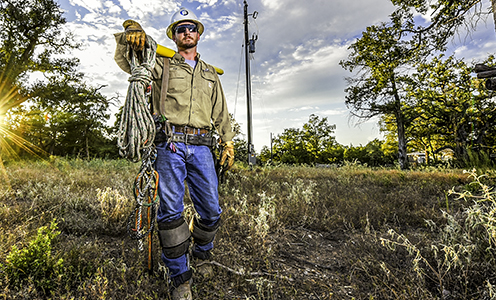The cooperative way
Recent news
Portables can be helpful in a power outage, but users should practice caution
Portable generators may be a godsend during a prolonged electrical outage, but they can be dangerous and owners should be extremely careful while operating one. A portable generator typically runs on gasoline, although some use diesel or propane. Portables are by far the most frequently used type of generator, and can cost from about $400 up to $2,500. Many are purchased at large home-improvement stores.
They can provide 3,000 to 8,500 watts of power, which is enough to power a few essential items, such as a refrigerator. They cannot power an entire house. Portable generators can produce harmful levels of carbon monoxide if operated in an enclosed area, and carbon monoxide poisoning is the cause of hundreds of deaths nationally each year.
If you are getting, or already have, a portable generator, follow these tips:
- Keep the generator dry and do not use it indoors, in a garage, near open doors or windows, or in rainy or wet conditions. A generator cover can protect it from the elements.
- Never try to power your house by plugging the generator into a wall outlet in your house or garage. This dangerous practice can reverse the electricity flow and send electricity out of your house and onto power lines. This can endanger line workers and your neighbors.
- When plugging something into the generator, use the proper type of extension cord that is in good condition. Frayed or ungrounded cords could cause a fire or electric shock. Overloading a multi-plug extension cord can be dangerous.
- Keep your generator on a flat, stable surface, with its exhaust venting away from windows and doorways to prevent carbon monoxide poisoning. Install battery-operated carbon monoxide alarms in your home.
- Don’t overload a portable generator. Look at its power rating. Most portable generators can only power a single appliance such as a refrigerator plus a few small battery-powered devices.
- Larger, permanently mounted standby generators are more powerful, but they are much more expensive (they can start around $4,000 and rise well above $10,000) and must be installed by a licensed, qualified electrician.
Contact a Bluebonnet member service representative at 800-842-7708 from 8 a.m. to 5 p.m. Monday through Friday if you are having a standby generator installed. There can be a wait time for delivery and installation.
A Bluebonnet line worker must disconnect power to the home or business where the generator is being installed, inspect the connection from the generator to the meter to make sure it meets safety requirements, and then reconnect power when the job is done.
BY ED CROWELL
When Bluebonnet Electric Cooperative powered the first light bulbs in rural Central Texas in 1939, the World’s Fair in New York was unveiling an all-electric home with a dazzling kitchen, complete with a refrigerator, electric range, dishwasher, coffee maker, garbage disposal, food mixer and an automatic toaster.
To allow buyers in Texas and other states to get a close look at these life-changing devices, the federal Rural Electrification Administration outfitted a traveling show of circus tents filled with innovative home appliances. The caravan of dreams drew crowds by the thousands, and by the early 1940s, appliance sales were skyrocketing.
Wood-burning stoves, clothing washboards and heavy hand irons heated by a fire — all of which required backbreaking labor — were pushed aside for these conveniences of modern living.
The consumer race for electric appliances gained momentum as World War II ended in 1945. The post-war housing boom increased consumer demand for kitchen appliances as well as electric radios and then TVs.
By the 1950s, color televisions were available, though most popular TV shows aired in black-and-white until the late 1950s or early 1960s. General Electric made its household appliances pop by adding color such as Petal Pink and Canary Yellow (a design trend that may have influenced the future Apple CEO Steve Jobs in the late 1990s when he unveiled colorful “flavors” of the iMac personal desktop computer: blueberry, strawberry, lime, tangerine and grape).
At Bluebonnet’s then-headquarters in Giddings, electric appliances could be viewed and touched, just like in a retail showroom. Bluebonnet held appliance demonstrations in small towns and communities across its service area.
The 1960s and 1970s brought the ability to save substantial time on cooking. Microwaves, Crock-Pots and Mr. Coffee — the first automatic drip machine — were unveiled and embraced by consumers. Cuisinart food processors and hot-air popcorn poppers also made kitchen time less onerous.
Again, Bluebonnet took center stage to help consumers understand how all those new appliances could change lives. Bluebonnet hired Lavonne Morrow to demonstrate microwave cooking, and some events drew more than 100 eager learners. She shared recipes for microwave casseroles, three-minute fudge and even a tiny birthday cake baked in an ice cream cone. To consumers’ amazement, she showed how an entire meal for six people could be prepared and cooked in a microwave in just 30 to 45 minutes.
Clearly, electric appliances were changing American culture. The convenience of a microwave, washing machine or vacuum cleaner freed more time for work outside the home. Growing numbers of American women joined the workforce for a paycheck.
America turned its attention to the environment in the 1970s, as oil and gas supply crises brought long lines at the gas pumps and prompted President Jimmy Carter to ask Americans to save energy by turning thermostats to 65 or lower in the winter.
It’s no surprise that the 1980s and 1990s saw advances in energy efficiency in home appliances and a big turn toward automation. In 1992, the Environmental Protection Agency introduced the Energy Star program to promote the purchase of energy-efficient appliances.
Today’s digital age is bringing increasingly “smart” electronics into the home that merge internet connectivity with phones, computers, artificial intelligence devices and appliances. Alexa, the voice-activated virtual assistant in the Amazon Echo device, was unveiled in 2016, and 100 million had been sold by the end of 2018, according to the company. A seemingly endless stream of other new devices can connect with the Echo or its top competitor, Google Home. Virtual assistants can turn on and off smart appliances and timers, stream music and read books to you, and each adds new skills regularly. A glut of smart security cameras that allow you to view the outside or inside of your home on your phone are popping up everywhere.
In the living room, consumers are making way for big-screen televisions with curved displays, screens that roll up and down and technology that illuminates every pixel in the screen. That means viewers can sit at any angle to the screen without a distorted image.
Some of today’s refrigerators have cameras inside to show whether you need to buy milk or eggs when you check from a smartphone while at the grocery store. Samsung’s $4,100 fridge also has a computer screen on the outside door for searching recipes, displaying family photos and keeping lists and calendars. GE’s new Kitchen Hub is a smart screen on a stove ventilation hood. It controls the thermostat and lights, security cameras, and other smart appliances. Users can stream movies and music and have video chats.
Or, there is always the option to just ignore all of these chatty, mind-boggling innovations.
Today’s refrigerators are a long way from the Giddings High School “home ec” classes that Shirley Hannes began teaching in 1961. She commanded four kitchen nooks filled with stoves, refrigerators, washers and dryers, all loaned by Bluebonnet. Hannes made certain her students knew how to use the latest in home appliances, some of which must have glowed in mid-century hues of Harvest Gold and Avocado.
Hannes, who now lives south of Houston in Pearland, doesn’t want a virtual assistant like Alexa, but she loves the two-door refrigerator she bought in 2018 because it makes and dispenses ice.
She’s not one to replace appliances just to have the newest model. “We built our house in 1976, and the stove was new then,” she said. “It’s still in good shape, so I’m not planning to replace it yet.”
BY CLAYTON STROMBERGER
As you drive down quiet, tree-lined Mulberry Avenue out on the southwestern edge of Luling, just past the high school football stadium, you come to an unadorned metal archway that reads, “The Luling Foundation,” and below that, “Est. 1927.” Passing under the arch, you’re simultaneously going backward and forward in time.
This area of gently rolling land nestled above the winding San Marcos River is both a historical site with a unique role in Caldwell County’s past and a working farm of tomorrow where cutting-edge practices are shared with the next generation of farmers and cattle ranchers.
The Luling Foundation exists because of Rafael Rios No. 1, the most famous oil well in the county’s history. Thanks to that well, drilled in 1922 after six dry misses, Yankee entrepreneur-turned-wildcatter Edgar B. Davis hit black gold and became even more of a millionaire than he’d been upon making his first two fortunes in the shoe and Indonesian rubber businesses.
Guided by the devout Congregationalist faith of his Massachusetts upbringing, Davis believed that “gracious Providence” had directed him to seek oil near Luling. That same spirit led him to share much of his newfound wealth through philanthropic gifts to the community he’d come to know and care for during his days of searching.
Touched by the plight of area farmers who appeared trapped in a cycle of diminishing returns due to reliance on the single crop of cotton, Davis created the Luling Foundation as an agriculture demonstration farm and endowed it with $1 million (the equivalent of more than $14 million today).
Over the decades, the Luling Foundation — which serves Caldwell, Gonzales and Guadalupe counties — has tested and shared best practices for growing row crops, pecans and winter forage crops for livestock, while raising, at various times, goats, dairy cows, turkeys and, since 2000, Angus cattle.
Produce from its gardens have graced many a Luling dinner table, and generations of Texas schoolchildren have enjoyed a daylong taste of farm life on memorable field trips. The foundation gives $15,000 in scholarships annually to high school students to pursue learning in agriculture, health care and trade/vocational studies.
The 1,100-acre facility is run by manager Michael Kuck and three other full-time staffers. The foundation is led by a seven-member board of directors. Board chair Gary Dickenson of Caldwell County first visited the farm at a 1984 field day, and has been a director since 2000.
Thank a farmer — celebrate National Ag Day
It’s a good day to reflect on and appreciate the contributions of American farmers, who receive just 14.8 cents, on average, of every food dollar consumers spend throughout the year, according to the National Farmers Union. The remaining 85 percent of food revenue goes to marketing, processing, wholesale, distribution and retail costs.
National Ag Day coincides with the beginning of cotton, corn, sorghum and soybean planting season for many Texas farmers. Think of the wide variety of commodities and products those crops alone make possible — clothing and other textiles, animal feed, renewable fuels such as ethanol and many convenience foods.
With each U.S. farmer feeding an average of about 165 people in exchange for a modest financial reward and, frequently, a lack of recognition, take a moment to honor the hard work they do for our country’s benefit and that of others around the world. Agriculture is America’s No. 1 export, a vital contributor to sustaining a healthy economy.
So support your local farmers’ markets, farm-to-table restaurants and spread the word about your favorite local farms.





